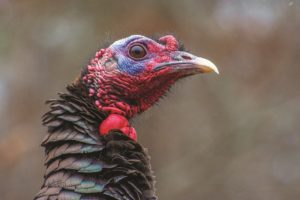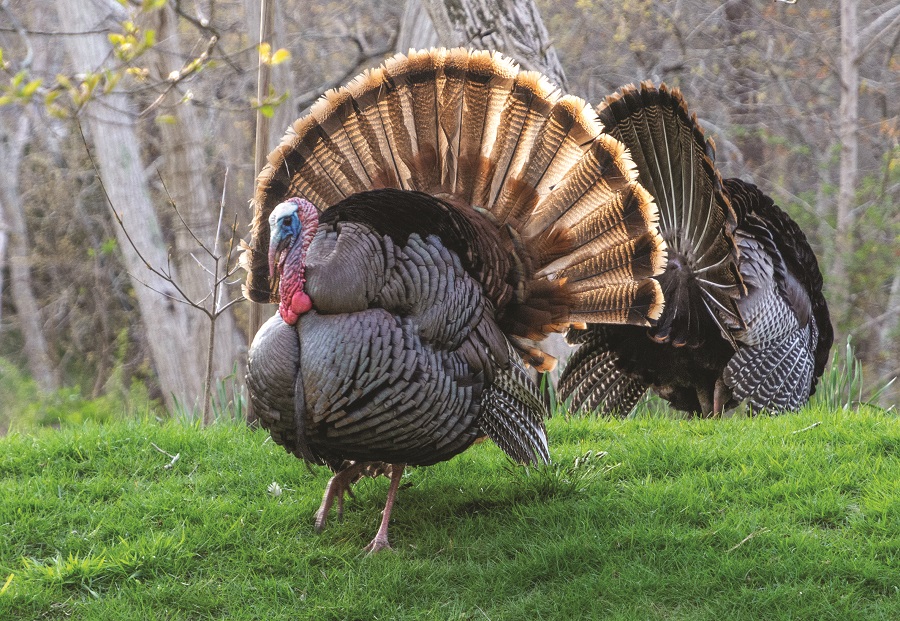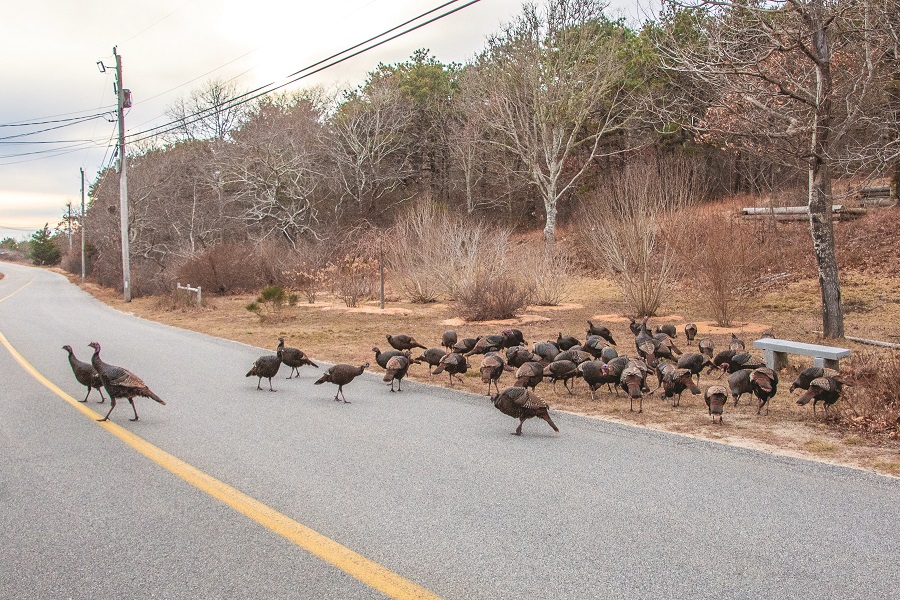They came from New York — 37 of them, trapped with a cannon-net set by Massachusetts wildlife biologists — to the Berkshires, at first. Then new generations spread statewide. Some arrived on two legs and in judders of flight, but most were transplanted by humans.
They made Cape landfall at Otis Air National Guard Base in 1991, the same year the wild turkey was named the state’s official game bird. That’s also the year, says Wellfleet oysterman, tracker, and naturalist Chopper Young, that turkeys touched down on Wellfleet’s High Toss Road. There they bred, learned to live in sand and scrub, to scratch for grubs beside Route 6, to fear no car or bike or city tourist. They made themselves at home here.

Turkeys had been here before. But the last known native bird was killed in 1851. Now, the Outer Cape’s share of Massachusetts’s 35,000 wild turkeys — “that number’s conservative,” says David Scarpitti, Turkey and Upland Game Project Leader for the Div. of Fisheries and Wildlife — are emerging into plain sight, looking for love.
But wait — a correction from Irwin Schorr, the Cape Cod Museum of Natural History’s “turkey guy”: wild turkeys do not fall in love. Some swans, cranes, titmice, and geese mate for life. So does the macaroni penguin. But the wild turkey is made of fickler stuff. “I guess,” says Scarpitti, “I’d say they’re amorous.”
All fall and winter, wild turkeys amble. They amble in drab rafters — flocks — through chosen stretches two miles wide, at most. The turkeys you see one December day are likely the same ones you saw the week before. Theirs is an unfussy life, says Schorr. They scrounge for acorns, rosehips, bugs. They stop traffic, tear up lawns. In the October-November hunting season (and again in the spring), they sometimes run from the bows and barrels of Cape Cod’s hunting folk. “That gives the birds a little life value,” says Young.

Then spring kicks into gear. Real daylight makes a comeback — and all at once, says Scarpitti, “eons of evolution” remind the turkey what to do.
Even in nonbreeding months, the rafter’s tom is striking. Tactful Schorr calls him “big-boned.” He is black, wing-barred, bearded from the breastbone. Caruncles — warts, nubs, “a bad case of acne,” says Schorr — dot his grayish head. His wattle swings below his neck. On his beak sits a fleshy horn: his snood. He is, says Scarpitti, “quite physically impressive.” He is, says Young, “sure something.”
Come April, the tom ambles no more: springtime is for strutting. Amorous, the tom rediscovers his potential. His head stays gray when he chooses, but he all at once has range. He can make himself red, or blue, or white. Those caruncles can turn purple. His snood snaps back into action; reddens, swells, extends over the beak, and dangles. His springtime snood is a tom’s pride. When he fights a rival, he goes straight for the snood. “The goal is to disfigure,” says Schorr. “The ladies like a good-looking snood.”
The mood strikes — and in an instant, his tail unfolds. His breast and back puff out; he is twice his normal size, velvety, all iridescent greens and reds. His face flushes. His snood droops. He turns his crown pure white. Then he pulls his head back, drops his wings, and gobbles.

There’s no better description, says Scarpitti. “A turkey gobble just sounds like a turkey gobble. Nothing can really make a noise like it.” So, the tom gobbles. He drums, too, and spits, and, stomps, and puts on the greatest show he can — all for those green-drab hens who will, truth be told, says Schorr, “mate with any male who comes around.”
As April ends, the toms will fold up their tail fans and the hens will turn domestic. They’ll lay 12 or 15 eggs in a ground-leaf nest. The first week of June, their poults will hatch, try to live long enough to fly. They’ll amble their way through fall, and if they dodge the hunters, next time around, they’ll jockey for a spot in the ritual.
But that’s a long way away. What you have before you now is this year’s wild turkey courting season. And, says Schorr, “It’s something to witness.”
The spring turkey hunting season in Massachusetts opens on Monday, April 26 and ends on May 22. For details, search for turkey hunting on the mass.gov website.



